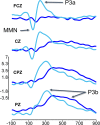Electrophysiological evidence of preserved hearing at the end of life
- PMID: 32587364
- PMCID: PMC7316981
- DOI: 10.1038/s41598-020-67234-9
Electrophysiological evidence of preserved hearing at the end of life
Abstract
This study attempts to answer the question: "Is hearing the last to go?" We present evidence of hearing among unresponsive actively dying hospice patients. Individual ERP (MMN, P3a, and P3b) responses to deviations in auditory patterns are reported for conscious young, healthy control participants, as well as for hospice patients, both when the latter were conscious, and again when they became unresponsive to their environment. Whereas the MMN (and perhaps too the P3a) is considered an automatic response to auditory irregularities, the P3b is associated with conscious detection of oddball targets. All control participants, and most responsive hospice patients, evidenced a "local" effect (either a MMN, a P3a, or both) and some a "global" effect (P3b) to deviations in tone, or deviations in auditory pattern. Importantly, most unresponsive patients showed evidence of MMN responses to tone changes, and some showed a P3a or P3b response to either tone or pattern changes. Thus, their auditory systems were responding similarly to those of young, healthy controls just hours from end of life. Hearing may indeed be one of the last senses to lose function as humans die.
Conflict of interest statement
Dr. Gallagher was a palliative care physician at St. John’s Hospice during the study.
Figures






Similar articles
-
Auditory pre-attentive processing of Chinese tones.Chin Med J (Engl). 2008 Dec 5;121(23):2429-33. Chin Med J (Engl). 2008. PMID: 19102963 Clinical Trial.
-
Preattentive cortical-evoked responses to pure tones, harmonic tones, and speech: influence of music training.Ear Hear. 2009 Aug;30(4):432-46. doi: 10.1097/AUD.0b013e3181a61bf2. Ear Hear. 2009. PMID: 19494778
-
Auditory P3a and P3b neural generators in schizophrenia: An adaptive sLORETA P300 localization approach.Schizophr Res. 2015 Dec;169(1-3):318-325. doi: 10.1016/j.schres.2015.09.028. Epub 2015 Oct 9. Schizophr Res. 2015. PMID: 26481687
-
Assessing cross-modal target transition effects with a visual-auditory oddball.Int J Psychophysiol. 2018 Jul;129:58-66. doi: 10.1016/j.ijpsycho.2018.04.010. Epub 2018 Apr 30. Int J Psychophysiol. 2018. PMID: 29723555
-
Explaining the high voice superiority effect in polyphonic music: evidence from cortical evoked potentials and peripheral auditory models.Hear Res. 2014 Feb;308:60-70. doi: 10.1016/j.heares.2013.07.014. Epub 2013 Aug 3. Hear Res. 2014. PMID: 23916754 Review.
Cited by
-
Listening Until the End: Best Practices and Guidelines for Auditory Care in Palliative Sedation in Europe.Healthcare (Basel). 2025 Jul 10;13(14):1664. doi: 10.3390/healthcare13141664. Healthcare (Basel). 2025. PMID: 40724689 Free PMC article. Review.
-
Life in Suspension with Death: Biocultural Ontologies, Perceptual Cues, and Biomarkers for the Tibetan Tukdam Postmortem Meditative State.Cult Med Psychiatry. 2025 Jun;49(2):434-464. doi: 10.1007/s11013-023-09844-2. Epub 2024 Feb 23. Cult Med Psychiatry. 2025. PMID: 38393648 Free PMC article.
-
No Detectable Electroencephalographic Activity After Clinical Declaration of Death Among Tibetan Buddhist Meditators in Apparent Tukdam, a Putative Postmortem Meditation State.Front Psychol. 2021 Jan 28;11:599190. doi: 10.3389/fpsyg.2020.599190. eCollection 2020. Front Psychol. 2021. PMID: 33584435 Free PMC article.
-
Electrocerebral Signature of Cardiac Death.Neurocrit Care. 2021 Dec;35(3):853-861. doi: 10.1007/s12028-021-01233-0. Epub 2021 Jun 28. Neurocrit Care. 2021. PMID: 34184175 Free PMC article.
-
Children's inhibition skills are associated with their P3a latency-results from an exploratory study.Behav Brain Funct. 2022 Dec 1;18(1):13. doi: 10.1186/s12993-022-00202-7. Behav Brain Funct. 2022. PMID: 36456950 Free PMC article.
References
-
- Tapson K, Sierotowicz W, Marks-Maran D, Thompson TM. ‘It’s the hearing that is last to go’: a case of traumatic head injury. Br. J. Nurs. 2015;24:277–281. - PubMed
-
- French CC. Near-death experiences in cardiac arrest survivors. Prog. Brain Res. 2005;150:351–367. - PubMed
-
- Greyson B. Dissociation in people who have near-death experiences: out of their bodies or out of their minds? The Lancet. 2000;355:460–463. - PubMed
-
- Parnia S, Fenwick P. Near death experiences in cardiac arrest: visions of a dying brain or visions of a new science of consciousness. Resuscitation. 2002;52:5–11. - PubMed
-
- Parnia S, Waller DG, Yeates R, Fenwick P. A qualitative and quantitative study of the incidence, features and aetiology of near death experiences in cardiac arrest survivors. Resuscitation. 2001;48:149–156. - PubMed
Publication types
MeSH terms
LinkOut - more resources
Full Text Sources
Medical

